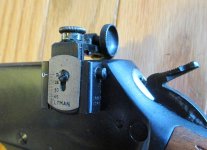Your mileage may vary and I am not one to bash Italian reproduction. I consider them to be fine firearms at least the quality of workmanship of Miroku if not better today. I stated that I could hit a 12" gong at 300 yards, but have no idea what the spread is. Your rifle may shoot better than mine, but there are lots of excuses that can be made about why I am not there yet.
I still state that leverguns are not built to give the kind of accuracy that you can always rely on at 300 yards. With the right load, the right sized bullet, right weight bullet, the OAL, etc. I can probably tighten up the group and I am still working at it. I also shoot the 45-90 Sharps at the bottom of my reproduction collection image, but shooting a single shot rifle cannot be compared to shooting a lever-action rifle. My Sharps is much more accurate than any of my leverguns will ever be, but the OP has a short barreled lever-action Marlin, not a single shot. Of course just about all modern bolt action rifles are more accurate than any of the above, especially if you put a scope on it.
Bottom line for me is would I rely on a levergun to cleanly kill big game at 300 yards, absolutely not.



